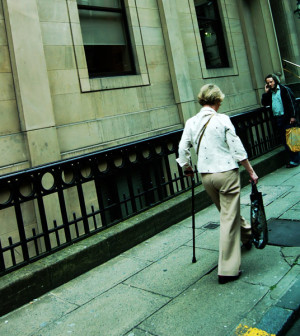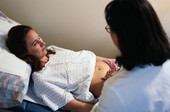- Skip Storing This Everyday Product in the Fridge Door
- Green Tea + B3 Pairing May Boost Brain Health
- Navigating Your Midlife Crisis: Embracing New Possibilities
- City Raccoons Showing Signs of Domestication
- Mapping the Exposome: Science Broadens Focus to Environmental Disease Triggers
- One Week Less on Social Media Linked to Better Mental Health
- Your Brain Changes in Stages as You Age, Study Finds
- Some Suicide Victims Show No Typical Warning Signs, Study Finds
- ByHeart Formula Faces Lawsuits After Babies Sickened With Botulism
- Switch to Vegan Diet Could Cut Your Greenhouse Gas Emissions in Half
Women in Labor May Be Fine Taking in Nourishment, Study Finds


SATURDAY, Oct. 12There may be good news for moms-to-be: A new study finds that women in labor and delivery may not have to forgo all nutrition or rely solely on ice chips to rehydrate, as is typically the case now.
Researchers say that allowing women to drink a protein shake during labor actually led to higher satisfaction rates among the laboring moms.
“We’ve found that not being able to eat or have any type of sustenance during labor and delivery is tough on the mom, who can labor for a long time. And, labor is like an aerobic exercise. By taking in extra calories, it helps ease the feeling of starvation and moms can feel better,” said the study’s senior author, Dr. Manuel Vallejo, a professor and chair of the department of anesthesiology at the West Virginia University School of Medicine in Morgantown, W.V. Vallejo was working at the University of Pittsburgh Medical Center at the time of the study.
Dr. Ashley Roman, an obstetrician and gynecologist at NYU Langone Medical Center in New York City, agreed that labor is akin to serious exercise.
“Labor is like a marathon, and it puts an unparalleled stress on women’s bodies,” she said. “It’s nice to know that we can give women more than ice chips or water during labor. It’s nice to know we can give them something caloric.”
Results of the study were scheduled for presentation on Saturday at the annual meeting of the American Society of Anesthesiologists in San Francisco. Findings presented at medical meetings are typically considered preliminary until published in a peer-reviewed journal.
Since the 1940s, women have been restricted to a minimal amount of ice chips and water while they’re in labor, according to background information in the study. There were several reasons for this practice. One was a concern that emptying of the stomach would be delayed when women were in labor, and that slow digestion could lead to nausea and vomiting during labor or delivery. Another concern was that if a woman needed general anesthesia at any point during labor or delivery, that any food or liquid present in the stomach could be breathed (aspirated) into the lungs.
Improved general anesthetic techniques have reduced the risk of aspiration, and the use of general anesthesia during childbirth is much rarer now, according to both Vallejo and Roman.
Still, the practice of limiting women to ice chips — or in some hospitals clear liquids, which includes Jell-O — leaves laboring women hungry, and possibly dehydrated or with low blood sugar levels, the study authors said.
According to Vallejo, prior research had suggested that protein shakes containing 30 grams of protein given during chemotherapy helped lessen nausea and vomiting for cancer patients. That made his team wonder if a protein shake would have a similar effect on the nausea and vomiting that many women experience during labor.
Their study included 150 women who underwent epidural anesthesia, a regional anesthetic that numbs just certain areas of the body. Aspiration isn’t a concern with an epidural.
The women were randomly assigned to be given a protein shake and ice chips or water as they wanted, or just ice chips or water.
Vallejo’s team found no significant differences in rates of nausea and vomiting between the two groups. What they did find was a greater level of satisfaction in the group that received the protein shake during early labor.
The researchers looked at another 18 women — half who received a protein shake and ice chips or water, and half who just received ice chips and water — and measured how quickly their stomachs emptied during labor. Vallejo said it was about 20 minutes for ice chips or water and about 26 for the protein shake. He said this isn’t a big enough difference to be concerned about.
“In patients who are otherwise healthy, we should have a more liberal policy on what women can have during labor. A clear liquid diet or a protein shake should be OK,” Vallejo said.
Roman agreed. “I think most places are already offering clear liquids during low-risk labor,” she said. “But this study does have the potential to change practice in that it gives reassurance, and it has the potential to improve patient satisfaction and also make patients more comfortable.”
She added that low-risk moms include those who haven’t had a prior surgical delivery (cesarean-section), women carrying one baby that’s normal in size, and women who are not having problems with the progression of labor.
More information
Learn more about what to expect during childbirth from the U.S. National Library of Medicine.
Source: HealthDay
Copyright © 2025 HealthDay. All rights reserved.










